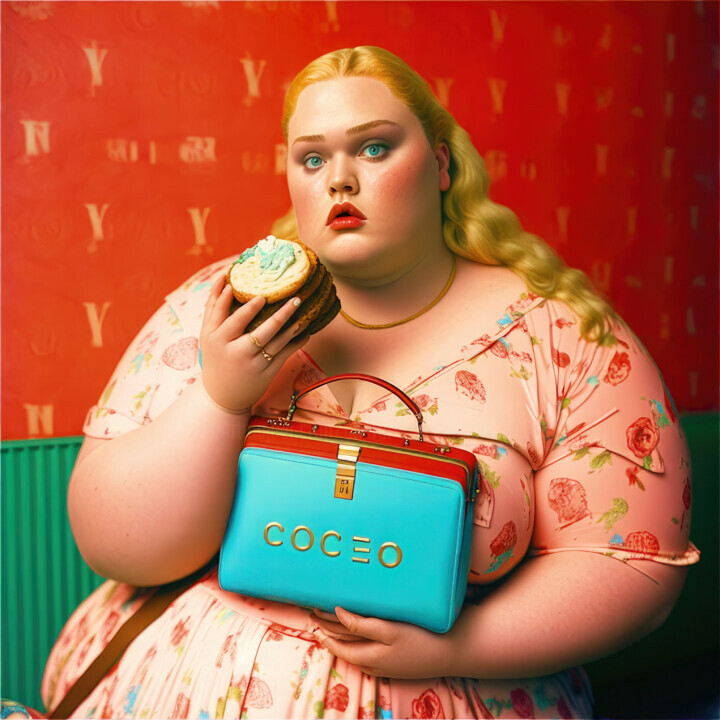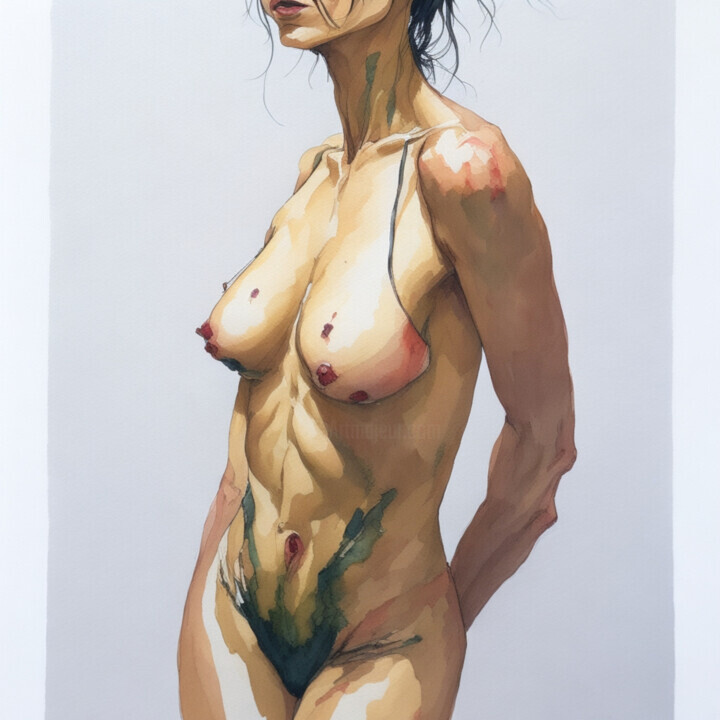 BEAUTIFUL (2023)Digital Arts by H.K.R. Braun.
BEAUTIFUL (2023)Digital Arts by H.K.R. Braun.
Can AI be compared to photography?
Do you remember when the French painter born in 1797 Paul Delaroche, faced with the rise of the photographic medium, declared: as of today, painting is dead? This quote highlights how the relationship between photography and traditional art has been controversial from the outset, i.e. a sort of love and hate, enthusiasm and terror, born basically from a vision aimed at recognizing in shots a tragic substitution of the main function of painting: the ability to faithfully reproduce the real data. Many artists of the time, however, were able to overcome fears and skepticism by using the camera to study surface values, obtain particular views of the world, capture the fleeting moment, experiment with different framing, etc. It was precisely this latter approach, less dominated by the anxiety of confrontation between the two techniques, and more open to the search for mutual enrichment, that contruibured to the liberation of pictorial art from the need to bind itself to the faithful reproduction of reality, giving rise to the extremely unprecedented movements of the twentieth-century avant-garde. Now you may be wondering why I am talking about photography when I have expressly elected AI as the focus of my narrative, in fact the above example serves me to break down the skepticism, which this latest contemporary art form is arousing in artists, art critics and collectors, by reminding me a bit of the above story, of which we all know the happy ending: the progressive understanding and recognition of photographic art. Hoping that history is once again the result of courses and recurrences, I briefly take the opportunity to get to the heart of the more modern debate, pointing out how AI is often recognized as a kind of aggression against the work of "real" artists, in that its programs are capable of "stealing" existing images to create something new. In fact, such functioning could be compared to that of an artist's brain, which, necessarily inspired by its surroundings or the art of the past, presents indispensable points of reference in its work. Another viewpoint firmly opposed to the advance of AI is the one that sees the latter as a dangerous rival to the deeper and more intimate nature of art, since it is now technology that does what previously only man could: bring an aesthetic idea to life. In this case, the rebuttal becomes more arduous, as it is certainly not easy to accept that a machine can match human capabilities, churning out works that can excite, amaze, etc., despite the fact that one cannot even turn one's face away and not recognize how technology is now increasingly a part of our lives, making it impossible to stop the progress that has accompanied man since its dawn! Always encouraging artistic experimentation, which is necessarily the fruit of the times in which it is born, I want to leave the role of decreeing the success or otherwise of AI to time, thinking that something very similar to what has been the case with photography can surely happen. At this point I leave you, both to your reflections, and to my small selection of AI artists from Artmajeur, having the intention of briefly introducing you to the history and form of their work...
 LADY HORSE (2023)Digital Arts by Mariano Moriconi.
LADY HORSE (2023)Digital Arts by Mariano Moriconi.
 "DRESSCODE PASITHEA" NO23074 (2023)Digital Arts by Planète Inexistante.
"DRESSCODE PASITHEA" NO23074 (2023)Digital Arts by Planète Inexistante.
 ADDICTION 5 (2023)Digital Arts by Jean Luc Michon.
ADDICTION 5 (2023)Digital Arts by Jean Luc Michon.
Jean Luc Michon: Addiction 5
The title of Michon's digital art seems to allude to the strong passion, or rather addiction, that the effigy nurtures for technology, a tool, which, in addition to "enveloping" the upper part of the model's body, imposes itself as the technique behind the execution of the AI work itself, forming part of a limited edition of fifteen pieces, marked to explicate an apparent praise for virtual reality. In fact, referring to the artist's own words, he does his best, through the depiction of subjects "armed with modernity," to criticize today's addiction to the digital world, captured precisely by the depiction of characters, who appear totally immersed in an artificial world, ready to isolate them from the real one. It follows that Michon seems to be proposing his AI work to show the profitable uses of technology, namely those of artistic production, warning against the more passive activities capable of alienating and increasingly lonely humankind. Finally, briefly introducing Artmajeur's artist, Michon, first a graphic designer and then the art director of an advertising agency, has also been a fashion photographer for major brands, experiences that have certainly influenced his artistic subjects, marked by great elegance, class and attention to detail, aspects that take shape in within a figurative investigation always ready to embrace the latest innovations in creative technique.
 REBORN (2022)Digital Arts by Lorraine Lyn.
REBORN (2022)Digital Arts by Lorraine Lyn.
Lorraine Lyn: Reborn
Lorraine Lyn is a multifaceted artist, who, constantly open to technical experimentation, approached AI art approximately two years ago, a moment from which such technology moved in the service of creating works, having the intent to capture the multiple states of the human soul, captured to demonstrate how the artistic medium can also act as a tool by means, that is, capable of fostering the acquisition of awareness of the facets of our emotions, as well as inviting us to question our points of view, helping us to understand the deeper meaning of our existence. It is precisely in this vein that Reborn, an AI work that immortalizes the moment when a girl wakes up from the sleep of unawareness and, like a phoenix, rises from her ashes to become even more beautiful, through the gift of consciousness, a tool ready to bring her before that new beginning we all so eagerly await. Speaking of lighter themes, particularly female depictions marked by the presence of conspicuous red lipstick, just like the one worn by the protagonist of Reborn, I feel I can liken the work of Artmajeur's artist to that of Tamara de Lempicka, an artist who in such masterpieces as Self-Portrait on the Bugatti, Sleeping girl, Girl in Green with Gloves, etc. probably wished to associate the idea of a woman strong and independent, and therefore always ready to be reborn, with that of a figure expertly groomed in appearance.
 MAN IN A FIELD OF PINK FLOWERS 40X60 (2022)Digital Arts by Kristi Bell.
MAN IN A FIELD OF PINK FLOWERS 40X60 (2022)Digital Arts by Kristi Bell.
Kristi Bell: Man in a field of pink flowes
Two gleaners appear depicted with their heads bowed, intent on concentrating their efforts on picking up the ears of grain that have fallen to the ground on the freshly harvested field, while a third figure is about to stand up, probably with the purpose of storing the grains in her bag. This entire scene just described is surrounded by large sheaves that appear in the background, a point on the canvas where the figures of some men and women, who continue to arrange the harvested plants, can also be distinguished. I have just tried to "repaint" Jean-François Millet's masterpiece, titled The Gleaners, to show how, in most cases, art history has associated fields with figures of workers. As for the Artmajeur artist's work, on the other hand, the subject depicted as unusually still within the aforementioned landscape brings to fruition the intent of the Convenient person series, designed to explicate the consequences of a difficult upbringing, taking place in families where children, neglected by their parents, constantly seek points of reference, just as the waiting protagonist of Man in a field of pink flowes would seem to do. Finally, speaking of Bell, Artmajeur's multimedia artist, who began his journey with photography, admits to using the tool of art to free himself from labels, discover himself and pursue the dream of intellectual freedom.
 HEY JOY! (2023)Digital Arts by Andy Paradyse.
HEY JOY! (2023)Digital Arts by Andy Paradyse.
Andy Paradyse: Hey joy
Referring to the artist's words of Artmajeur Paradyse, Hey joy, an AI work depicting an elegant shapely girl, who, holding a candy bar, seems to have forgotten even her name, lost in another dimension filled with thoughts and associations, represents the most plausible interpretations of an alternative paradise, that is, of a special place, graceful, peaceful, full of color and pleasant characters. The description just given is enriched by the artist's awareness of making works akin to the current of Surrealism, although in the case of Hey Joy it would be possible to juxtapose the round forms of the effigy with the example of the bursting fertility of Paleolithic Venuses, as well as with the figurative investigation of Botero, a painter who chose these particular features of the woman, to deepen the study of volumes and emphasize the sensuality of the form. It is precisely in this sense, however, that we can return to the concept of Surrealism, inasmuch as, from what emerges from interviews over the years with the Colombian master, it has emerged how fat has a purely stylistic function for him, aimed at eschewing realism in order to use abundance as a symbol of the transformation of reality.
 SIMONE (2023)Digital Arts by Ingo Caun.
SIMONE (2023)Digital Arts by Ingo Caun.
Ingo Caun: Simone
A standing female nude body presents itself in front of the viewer without any shyness, although perhaps, such confidence, can certainly be fostered by the fact that we cannot know the identity of the effigy, as her face is cut off at the upper end of the support. It is precisely this feature that makes Caun's AI work extremely interesting, for if we think of the best-known nudes in art history, such as Olympia, Sleeping Venus, Leda and the Swan, etc., all of these masterpieces immortalize, perhaps somewhat "monotonously," the human figure in its entirety. So I wanted to look into the matter further by investigating whether, if any, the artist in Artmajeur might have taken a cue from the framing of some other nude from the past, so that I discovered how a similar device of depiction has been used by such masters as Munch, de Chirico, Man Ray, Duchamp, Chagall, etc., artists who did not make the face of their model explicit without clothing very well. Returning to the work of the artist from Artmajeur, the nude in question was made in somewhat realistic stylistic stylings, intended to take on the appearance, in some places, of the streaks typical of the watercolor technique, of which Caun claims to be a master, although his more current work shows how he has succumbed to the allure of new art technologies, often capable of simulating the most iconic techniques of figurative storytelling.


 Olimpia Gaia Martinelli
Olimpia Gaia Martinelli











